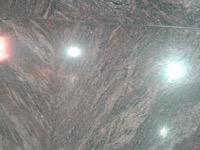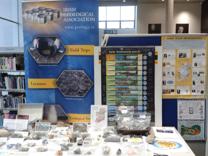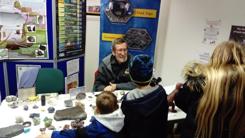
6 minute read
Report on the Dimension Stones at Dundrum Town Centre
Report on IGA Field Trip to Dundrum Town Centre Shopping Mall
Date: 14th August, 2019
Advertisement
This field trip needed neither rain gear nor hiking boots! Expertly led by Susan Pyne, its purpose was to examine the beautiful dimension stones that pave the shopping mall on different levels, inside the Dundrum Town Centre development. This shopping mall was opened in 2005 and the polished paving slabs have been sourced from such faraway places as South Africa and the Himalayas. They provide examples of the three main types of rock: igneous, metamorphic and sedimentary.
Dimension stones in Dundrum Town Centre
The first location visited was on Level 3, where the floor of the mall is paved with a type of GNEISS. Susan explained that this is a metamorphic rock, formed when the original igneous rock was subjected to heat and great pressure. The polished stone shows bands of pink material, alternating with darker bands, which are almost black. The crystals are aligned in particular directions, caused by the pressure to which they were subjected. Tiny garnet crystals are present.This stone probably came from South Africa. (See Photo on the right:)
Next, we descended to Level 1, to examine a green polished stone, which, Susan told us, originated deep within the Earth’s mantle as PERIDOTITE. The main mineral present is OLIVINE, which is a silicate of magnesium and/or iron. It contains individual SiO44- ions, whose charge may be balanced by two Fe2+ ions, or two Mg2+ ions, or both. In fact, olivine forms a solid solution whose composition ranges from Fe2SiO4 to FeMgSiO4 to Mg2SiO4 and everything in between. Being rich in magnesium (Mg) and iron (Fe), it is classified by geologists as a mafic material. In this particular stone, the original olivine has been weathered by contact with water, to form SERPENTINE. In addition, the rock has become broken up into sharp pieces and then cemented together to form a type of BRECCIA. Builders refer to this polished stone as serpentine ‘marble’, but in fact it is not really marble as a geologist would understand the term.
Gneiss from South
Serpentine Breccia
Report on trip to Dundrum Town Centre (Continued from page 6)
The third location we visited on this field trip was back on Level 3 again, where we saw a paler coloured gneiss, with veins containing granitic material and black crystals of tourmaline.
A most interesting dimension stone that we examined on this field excursion was the creamcoloured polished LIMESTONE, which came from Germany. This is an example of sedimentary rock, evident from the many fossils it contained. There were also similar limestone slabs with a pale grey colour. The fossils included ammonites, belemnites and corals and these fossils indicate that the sediments were laid down during the Jurassic period. The rocks show some iron staining, because the limestone has traces of hematite. In fact, shiny pieces of specular (mirror – like) hematite could be seen in places.
Cream coloured limestone, alternating with grey limestone slabs Belemnite fossil in limestone,
Finally, we examined an example of an igneous rock. This was PEGMATITE, a rock similar in composition to granite, but which cooled extremely slowly, allowing large crystals to grow. We could see well-formed crystals of pink monoclinic feldspar, colourless quartz, as well as black crystals, which may be biotite. Susan told us that this rock probably came from the Himalaya mountains.
Pegmatite from the Himalaya Mts.
This trip was a real eye-opener for us; no doubt, the next time we go shopping, we will pay more attention to what is under our feet, rather than to what is displayed in the shop windows. It was very well attended and judging by the lengthy discussions at each location, evoked great interest among the group. On behalf of all of us who participated, I should like to thank Susan Pyne for her comprehensive and fascinating explanation of the geological origin of these dimension stones and for her patience in answering all of our many questions.
OUTREACH EXHIBITIONS in PUBLIC LIBRARIES 2019 -2020
To mark the IGA Diamond Jubilee year, exhibitions of rocks and minerals were held in two local libraries in the Midlands, as outreach events for the general public. The first was held in Athlone, October 10th - 17th 2019, while the second was held at Portlaoise in January 2020.

The exhibit at Athlone Library
About half of all the items show in Athlone came from the rock and mineral collection at Athlone Institute of Technology. These included a selection of samples of galena and sphalerite from the Navan lead/zinc mine, as well as a core of the limestone bedrock with a vein of sphalerite in it. There was a lovely stone of Galway granite, which had been split, to show large crystals of K-feldspar inside, as well as many beautiful mineral specimens, such as calcite (with double refraction) gypsum, talc, rose quartz and aragonite. The IGA wishes to thank the Faculty of Engineering at AIT for the loan of these specimens and in particular, Geology lecturer Stephen Harney for his help and for making himself available to answer questions in the library on the final day of the exhibition.
The other Specimens on display were from the personal collection of IGA committee member Margaret Franklin, who had collected them on various field trips organised by the IGA. They included samples of volcanic rocks from the Aeolian islands, sedimentary rocks and fossils from the Jurassic Coast (in the south fo England) as well as metamorphic rocks and evaporites from the Greek island of Crete.
The exhibit attracted great interest from visitors to the library during the week. We would like to thank the chief libraryan and staff at Athlone Public Library for facilitating this exhibition.
Igneous rocks on display in Athlone
Geology Week in Portlaoise Library (21st -25th January 2020
Report and photos by Michele Castiaux
During the course of the week, Michele Castiaux did three children’s geology workshops, the first one on the 21st and two on 24th January (“Rock Detective”). The feedback from teachers and children were excellent.
Frank Clissmann and Susan Pyne kindly volunteered to join Michele on Saturday 25th January for a day of rock identification in the library. They also brought a fantastic range of minerals and fossils to display with Michele’s rock collection. People from the local area were invited to bring some samples for identification. There was huge interest from children and adults visiting the library. Thanks to the library’s excellent advertisement, the turnout was amazing.
It was inspiring and encouraging to see such interest in Geology by young and old.
Susan Pyne, Frank Clissmann & Michele Castiaux at Geology week in Portlaoise Library


We are looking forward to doing more library events in the not too distant future.
If any member is interested in organising a similar event in their local library, please let us know at info@geology.ie




